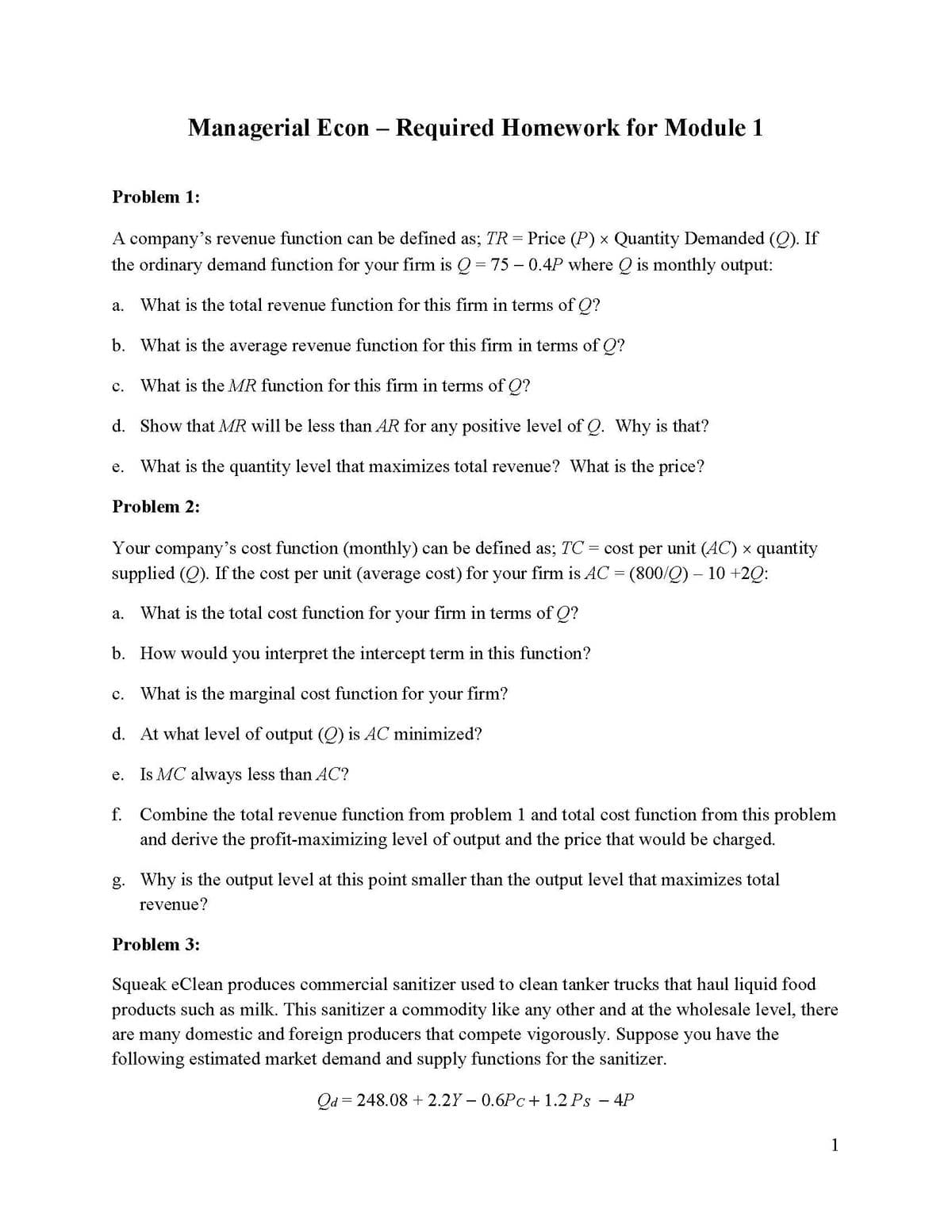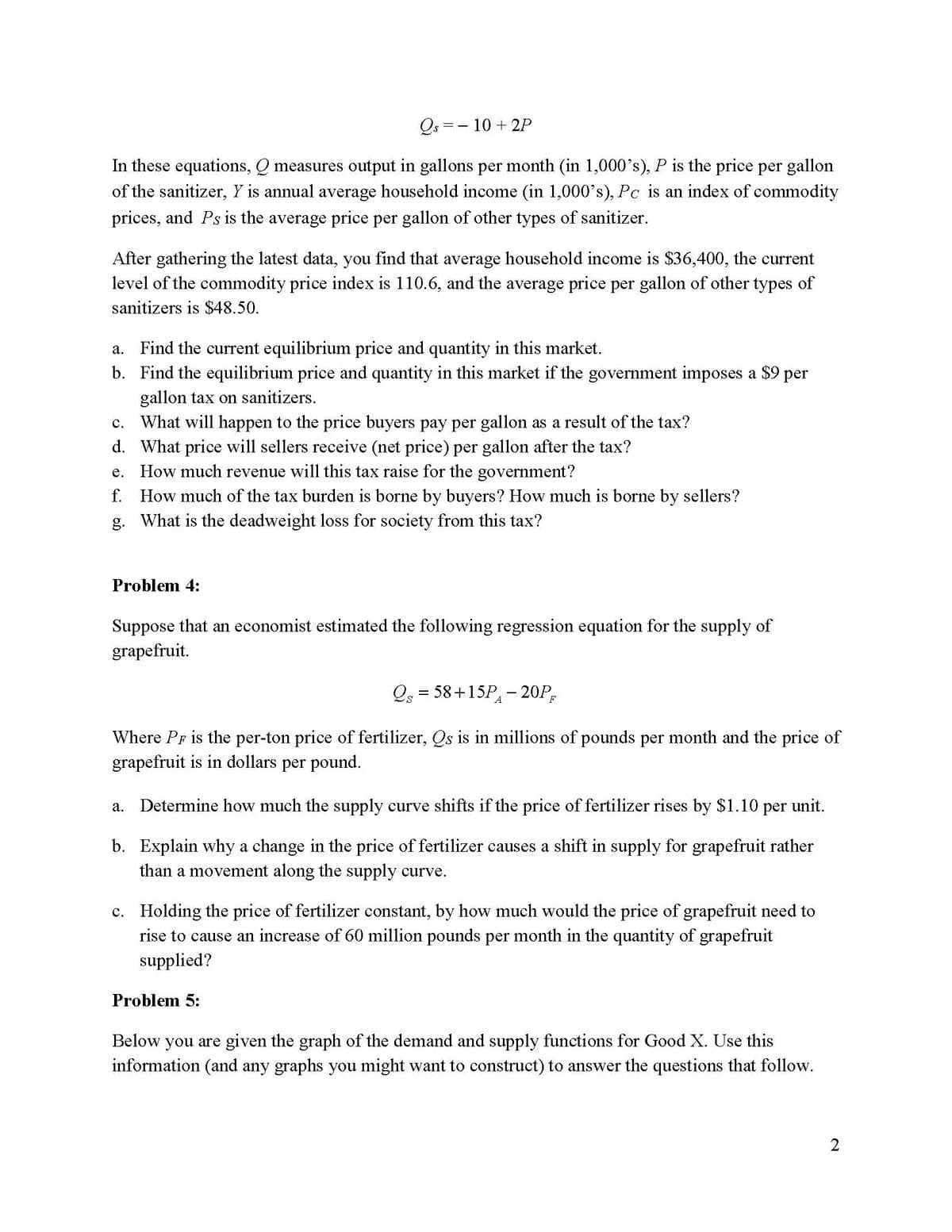Problem 1: A company's revenue function can be defined as; TR = Price (P) x Quantity Demanded (Q). If the ordinary demand function for your firm is Q = 75 -0.4P where Q is monthly output: a. What is the total revenue function for this firm in terms of Q? b. What is the average revenue function for this firm in terms of Q? c. What is the MR function for this firm in terms of Q?
Problem 1: A company's revenue function can be defined as; TR = Price (P) x Quantity Demanded (Q). If the ordinary demand function for your firm is Q = 75 -0.4P where Q is monthly output: a. What is the total revenue function for this firm in terms of Q? b. What is the average revenue function for this firm in terms of Q? c. What is the MR function for this firm in terms of Q?
Chapter17: Capital And Time
Section: Chapter Questions
Problem 17.10P: Wonopoly and natural resource prices Suppose that a firm is the sole owner of a stock of a natural...
Related questions
Question
Question 3 starts on page 1 and goes to page 2. Thank you

Transcribed Image Text:Managerial Econ - Required Homework for Module 1
Problem 1:
A company's revenue function can be defined as; TR = Price (P) × Quantity Demanded (Q). If
the ordinary demand function for your firm is Q = 75 -0.4P where Q is monthly output:
a. What is the total revenue function for this firm in terms of Q?
b. What is the average revenue function for this firm in terms of Q?
C. What is the MR function for this firm in terms of Q?
d. Show that MR will be less than AR for any positive level of Q. Why is that?
e. What is the quantity level that maximizes total revenue? What is the price?
Problem 2:
Your company's cost function (monthly) can be defined as; TC: cost per unit (AC) × quantity
supplied (Q). If the cost per unit (average cost) for your firm is AC = (800/Q) – 10 +2Q:
a. What is the total cost function for your firm in terms of Q?
b. How would you interpret the intercept term in this function?
c. What is the marginal cost function for your firm?
d.
At what level of output (Q) is AC minimized?
e.
Is MC always less than AC?
=
f. Combine the total revenue function from problem 1 and total cost function from this problem
and derive the profit-maximizing level of output and the price that would be charged.
g. Why is the output level at this point smaller than the output level that maximizes total
revenue?
Problem 3:
Squeak eClean produces commercial sanitizer used to clean tanker trucks that haul liquid food
products such as milk. This sanitizer a commodity like any other and at the wholesale level, there
are many domestic and foreign producers that compete vigorously. Suppose you have the
following estimated market demand and supply functions for the sanitizer.
Qd = 248.08 +2.2Y-0.6Pc+ 1.2 Ps - 4P
1

Transcribed Image Text:==
In these equations, Q measures output in gallons per month (in 1,000's), P is the price per gallon
of the sanitizer, Y is annual average household income (in 1,000's), Pc is an index of commodity
prices, and Ps is the average price per gallon of other types of sanitizer.
10 + 2P
After gathering the latest you find that average household income is $36,400, the current
level of the commodity price index is 110.6, and the average price per gallon of other types of
sanitizers is $48.50.
a. Find the current equilibrium price and quantity in this market.
b.
Find the equilibrium price and quantity in this market if the government imposes a $9 per
gallon tax on sanitizers.
Problem 4:
c. What will happen to the price buyers pay per gallon as a result of the tax?
d. What price will sellers receive (net price) per gallon after the tax?
e.
How much revenue will this tax raise for the government?
f. How much of the tax burden is borne by buyers? How much is borne by sellers?
g. What is the deadweight loss for society from this tax?
Suppose that an economist estimated the following regression equation for the supply of
grapefruit.
Qs = 58+15P₁-20P
Where PF is the per-ton price of fertilizer, Qs is in millions of pounds per month and the price of
grapefruit is in dollars per pound.
a. Determine how much the supply curve shifts if the price of fertilizer rises by $1.10 per unit.
b. Explain why a change in the price of fertilizer causes a shift in supply for grapefruit rather
than a movement along the supply curve.
Problem 5:
c. Holding the price of fertilizer constant, by how much would the price of grapefruit need to
rise to cause an increase of 60 million pounds per month in the quantity of grapefruit
supplied?
Below you are given the graph of the demand and supply functions for Good X. Use this
information (and any graphs you might want to construct) to answer the questions that follow.
Expert Solution
This question has been solved!
Explore an expertly crafted, step-by-step solution for a thorough understanding of key concepts.
This is a popular solution!
Trending now
This is a popular solution!
Step by step
Solved in 2 steps

Follow-up Questions
Read through expert solutions to related follow-up questions below.
Follow-up Question
- Show that MR will be less than AR for any positive level of Q. Why is that?
- What is the quantity level that maximizes total revenue? What is the price?
Solution
Knowledge Booster
Learn more about
Need a deep-dive on the concept behind this application? Look no further. Learn more about this topic, economics and related others by exploring similar questions and additional content below.Recommended textbooks for you

